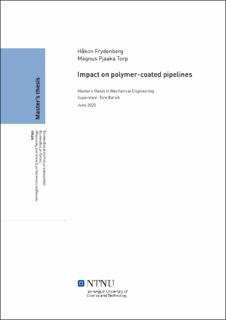| dc.contributor.advisor | Børvik, Tore | |
| dc.contributor.advisor | Vestrum, Ole | |
| dc.contributor.advisor | Kristoffersen, Martin | |
| dc.contributor.author | Frydenberg, Håkon | |
| dc.contributor.author | Torp, Magnus Pjaaka | |
| dc.date.accessioned | 2021-09-21T16:13:16Z | |
| dc.date.available | 2021-09-21T16:13:16Z | |
| dc.date.issued | 2020 | |
| dc.identifier | no.ntnu:inspera:56511028:29481538 | |
| dc.identifier.uri | https://hdl.handle.net/11250/2780026 | |
| dc.description.abstract | Denne masteroppgaven inneholder en eksperimentell og numerisk undersøkelse av den mekaniske styrken til undersjøiske rørledninger med isolasjonslag av polymer. Målet med oppgaven var å finne ut hvordan undersjøiske rørledninger med porøst polyuretan responderer under kvasi-statisk last. Dette arbeidet er en del av et forskningssamarbeid mellom SIMLab på NTNU og Equinor, der støt mot isolerte rørledninger er fokus.
Materialegenskaper for stål og porøst polyuretan (PU) ble bestemt fra eksperimenter. Strekktester av stålet ble gjennomført for å verifisere at stålet hadde stålkvalitet X65. Trykkprøver ble gjennomført på PU testprøver. Under trykkprøvene ble det observert at porøst PU var et sprøtt materiale. Røntgen mikro-computertomografi viste en variasjon av relativ tetthet i radiell retning i røret.
En komponenttest ble gjennomført ved kvasi-statisk inntrykking av to rørledninger på 1m med to forskjellige inntrykkingskniver. Det ble observert at PU-isolasjonen absorberte 18kJ og 11kJ av arbeid utført av henholdsvis stor og liten inntrykkingskniv før noe permanent deformasjon var synlig i stålrøret. En kort sammenlikning av PP- og PU-isolerte rør ble utført, der PU-isolasjonen absorberer mindre energi.
Kalibrering av materialmodeller ble gjort basert på eksperimenter og tidligere forskning ved NTNU. En Johnson-Cook material modell ble brukt på stålet, og sann spenning mot sann tøyning ble etablert for PU-isolasjonen. For PU ble disse verdiene modifisert til å passe inn i materialmodellen crushable foam (Deshpande and Fleck) i Abaqus, samt gjort responsen mykere for å ta hensyn til brudd som ikke har blitt kalibrert.
Alle eksperimenter ble simulert for å verifisere materialmodellene. Trykktesten av PU-isolasjonen og komponenttesten ble grundigere undersøkt. Isolasjonslaget i røret ble delt opp i 4 lag med forskjellige materialegenskaper avhengig av relativ tetthet. Det har ikke blitt brukt noe bruddkriterie i Abaqus, selv om dette ble observert i isolasjonslagene i eksperimentene. De numeriske analysene ga gode resultater. Til slutt ble en numerisk grensetilstandsanalyse (BC) utført for å undersøke endringer i responsen ved inntrykking av røret med mer realistiske BCs. | |
| dc.description.abstract | This master’s thesis presents an experimental and numerical investigation into the structural integrity of polymer-coated subsea pipelines. The objective was to find out how a porous polyurethane-coated subsea pipeline behaves when being subjected to quasi-static impact loading. This is part of an ongoing research collaboration between SIMLab at NTNU and Equinor, where impact loads on coated subsea pipelines are of interest.
Material properties of the steel and porous polyurethane (PU) were obtained by material experiments. Uniaxial tensile tests of the steel were conducted to verify the steel quality to be of grade X65, while uniaxial compression tests were performed on PU specimens. The PU was observed to be brittle during testing. X-ray micro-computed tomography mapped a variation of the relative density in the PU coating in the radial direction of the pipeline.
A component test was conducted by quasi-static denting of two pipeline sections at 1m each with two different indenter geometries. It was observed that the PU coating absorbs 18kJ and 11kJ of the work done by the big and small indenter, respectively, prior to permanent deformation of the steel pipe. A brief comparison of PP- and PU-coated pipeline designs is conducted, where the latter absorbs less energy in the coating.
The calibration of material models was established based on experimental results and previous research carried out at NTNU. A Johnson-Cook power law was applied to the steel, while true stress versus true strain relationship for the PU coating was obtained. This relationship was modified to fit the crushable foam material model (Deshpande and Fleck) in Abaqus/Explicit and softened to represent the extensive fracturing observed during experiments.
All experiments were numerically simulated in Abaqus/Explicit to validate and verify material models. Special attention was given to the PU coating and the component test. The coating layer in the component model was divided into 4 layers with different mechanical properties depending on the relative density. No fracture criteria were applied, although fracture was seen in the coating during the experiments. The numerical simulations yielded good results. Finally, a parameter study where the boundary conditions were changed in the numerical model was conducted to see the effects on the pipeline response with more realistic boundary conditions. | |
| dc.language | | |
| dc.publisher | NTNU | |
| dc.title | Impact on polymer-coated pipelines | |
| dc.type | Master thesis | |
